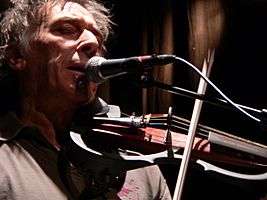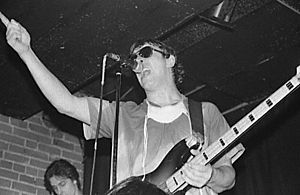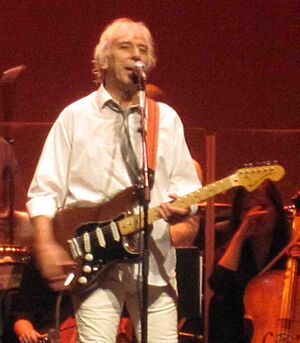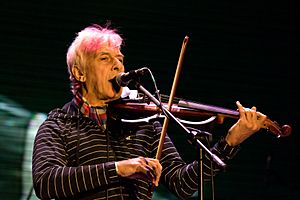John Cale facts for kids
Quick facts for kids
John Cale
|
|
|---|---|

Cale performing at De Warande in Turnhout, Belgium, 2006
|
|
| Background information | |
| Birth name | John Davies Cale |
| Born | 9 March 1942 Garnant, Carmarthenshire, Wales |
| Genres |
|
| Occupation(s) |
|
| Instruments |
|
| Years active | 1957–present |
| Labels | |
John Davies Cale OBE (born 9 March 1942) is a Welsh musician, composer, and record producer. He was a founding member of the American rock band the Velvet Underground. Over his long career, Cale has explored many different music styles. These include rock, drone, classical, avant-garde, and electronic music.
John Cale studied music at Goldsmiths College, University of London. In 1963, he moved to New York City to join its exciting music scene. There, he performed with the Theatre of Eternal Music and helped start the Velvet Underground. After leaving the band in 1968, Cale released many solo studio albums. Some of his well-known albums include Paris 1919 (1973) and Music for a New Society (1982). Cale is also known for being a creative record producer. He helped produce the first albums for famous artists like the Stooges and Patti Smith.
Contents
Early Life and Musical Start
John Davies Cale was born on March 9, 1942. He grew up in the mining village of Garnant in South West Wales. His father was a coal miner, and his mother was a primary school teacher. John learned to speak Welsh from his mother. He started learning English around age seven.
Cale discovered a talent for playing the viola. At 13, he joined the National Youth Orchestra of Wales (NYOW). He received a scholarship to study music at Goldsmiths College, University of London. While there, he helped organize an early Fluxus concert in 1963. He also contributed to a short film and had some of his music published. In 1963, he traveled to the United States. He continued his music training with help from American composer Aaron Copland.
In New York City, Cale met many important composers. In September 1963, he took part in a very long piano performance. It was the first full performance of Erik Satie's "Vexations". This performance lasted over 18 hours. Cale later said that composer John Cage's ideas helped him have a more "relaxed" view on art.
Cale played in La Monte Young's group, the Theatre of Eternal Music. The music they played used a lot of drone sounds. This style greatly influenced his next band, the Velvet Underground. Sterling Morrison, who later joined the Velvet Underground, also worked with Cale on these early recordings.
The Velvet Underground Years (1964–1968)
John Cale enjoyed both rock music and experimental art music from a young age. In 1965, he co-founded the Velvet Underground with Lou Reed. They brought in their flatmate Angus MacLise and Reed's friend Sterling Morrison. Before their first paid show, MacLise left the band. He was replaced by Moe Tucker as the drummer. Her unique drumming style became a key part of the band's sound.
In 1965, Cale shared a rough demo tape of the Velvet Underground's music in Britain. Even though they didn't get a record deal right away, the tape spread. Other bands like the Deviants, the Yardbirds, and David Bowie covered Velvet Underground songs before their first album came out.
The Velvet Underground's first official recording was an instrumental track called "Loop." It was a sound experiment created by Cale. His creative partnership with Lou Reed was very important to the sound of the band's first two albums. These were The Velvet Underground & Nico (1967) and White Light/White Heat (1968). On these albums, Cale played viola, bass guitar, and piano. He also sang some backing vocals. On White Light/White Heat, Cale also played organ and sang lead on two songs. His electric viola sound was a special part of the band's music. He also played celesta on "Sunday Morning". Cale also played on Nico's first solo album, Chelsea Girl (1967).
Tensions grew between Reed and Cale. Reed told Morrison and Tucker that he would leave if Cale didn't. So, Cale played his last show with the Velvet Underground in September 1968. Moe Tucker said that when John left, the band became "a little more normal." After Cale left, Doug Yule joined the band.
Some believe that the creative disagreements between Cale and Reed shaped the band's early sound. When Cale left, the band's music became less experimental. Cale briefly returned to the studio in 1970. He played organ on a demo for the band's fourth album, Loaded.
Solo Career Highlights
The 1970s
After leaving the Velvet Underground, Cale became a record producer. He worked on albums for artists like the Stooges and Nico. He also played on Nick Drake's album, Bryter Layter (1971).
In 1970, Cale started his solo music career. His first solo album, Vintage Violence (1970), had a rich, roots-rock sound. In 1971, he released Church of Anthrax, a collaboration with minimal music artist Terry Riley. His 1973 album, Paris 1919, is considered one of his best. It featured melodic songs with complex lyrics.
Cale also continued to produce albums for other artists. He worked with Jennifer Warnes, Chunky, Novi & Ernie, and the Modern Lovers. In 1974, he signed with Island Records. He produced albums for bands like Squeeze, Patti Smith, and Sham 69.
In 1974, Cale moved back to London. He released a series of solo albums that had a new, intense sound. These included Fear (1974), Slow Dazzle (1975), and Helen of Troy (1975). He often performed a unique version of Elvis Presley's "Heartbreak Hotel" in his concerts.
In 1977, Cale released the EP Animal Justice. His loud and energetic live shows fit well with the growing punk rock scene. He sometimes wore a hockey mask on stage.
The 1980s

In 1980, Cale signed with A&M Records. He tried a more commercial sound with his album Honi Soit (1981). Andy Warhol created the cover art for this album. However, the album was not a big commercial success.
In 1982, Cale released Music for a New Society. This album was described as a very deep and powerful record. He followed it with Caribbean Sunset (1984). This album included contributions from Brian Eno. A live album, John Cale Comes Alive (1984), followed.
In 1985, Cale released Artificial Intelligence. This album used more synthesizers and drum machines. "Dying on the Vine" from this album is considered one of his best songs. That same year, he acted in a TV series called The Equalizer. He also wrote music for a TV movie based on a Kurt Vonnegut story.
Cale continued to produce albums for other artists. These included Lio's Pop model (1986) and Happy Mondays' first album (1987). In 1989, he released Words for the Dying, an album produced by Brian Eno. This album featured spoken and sung pieces based on poems by Welsh poet Dylan Thomas.
The 1990s
After Andy Warhol passed away in 1987, Cale worked with Lou Reed again. They released the 1990 album Songs for Drella, which was a tribute to Warhol. This album ended their 18-year separation. Later that year, the Velvet Underground reunited for a show in Paris, France. This led to a European tour in 1993 and a live album, Live MCMXCIII.
Cale also collaborated with Brian Eno again on the 1990 album Wrong Way Up. In 1991, Cale contributed a cover of "Hallelujah" to a tribute album for Leonard Cohen. Cale's version of the song became very popular and influenced many later covers.
In 1992, he sang on two songs for French composer Hector Zazou's album Sahara Blue. In 1994, Cale performed a spoken-word duet with folk rock singer Suzanne Vega.
In 1996, Cale released Walking on Locusts, his only solo studio album of the decade. This album featured appearances by Talking Heads' David Byrne and original Velvet Underground drummer Moe Tucker. He also composed music for a ballet called Nico, which was released as Dance Music (1998).
In 1998, Cale toured with singer Siouxsie Sioux. They performed together on several songs, including "Venus in Furs" by the Velvet Underground. Cale's autobiography, What's Welsh for Zen?, was published in 1999.
The 2000s
Cale's cover of "Hallelujah" gained more fame when it was used in the 2001 animated film Shrek. In 2002, Cale played piano and sang on a song for Gordon Gano's solo album.
In 2003, Cale signed with EMI Records. He released the EP 5 Tracks and the album HoboSapiens. These works showed his interest in modern electronica and alternative rock. His 2005 album was blackAcetate.
In 2005, Cale produced Alejandro Escovedo's album, The Boxing Mirror. In 2006, Cale released a single called "Jumbo in tha Modernworld." In 2007, a live album called Circus Live was released. It featured new versions of songs from his entire career. Cale also continued to work with other artists, playing viola on Replica Sun Machine and producing for Ambulance LTD.
In 2008, Cale hosted an event to honor Nico, called Life Along the Borderline. In 2009, Cale represented Wales at the Venice Biennale exhibition. He focused on his connection with the Welsh language.
The 2010s
In 2010, Cale was the first "Eminent Art in Residence" at the Mona Foma festival in Hobart, Tasmania, Australia. He performed his album Paris 1919 (1973) in its entirety at several venues around the world.
In October 2010, Cale released the live album Live at Rockpalast. In February 2011, Cale signed with Domino Records and released an EP, Extra Playful, in September 2011.
In May 2011, he performed at the Brighton Festival. In the autumn of 2012, Cale released Shifty Adventures in Nookie Wood, his first studio album since 2005. This album included a collaboration with Danger Mouse.
In 2014, he appeared in an episode of the TV series The Bridge. Cale released his sixteenth solo studio album M:FANS in January 2016. It featured new versions of songs from his 1982 album Music for a New Society.
In July 2016, Cale performed songs by David Bowie at a BBC Prom concert in London. In 2017, Cale performed with Moe Tucker at the Grammy Salute to Music Legends ceremony. The Velvet Underground received the Merit Award that year.
In February 2019, Cale worked with Marissa Nadler on her single "Poison." In September 2019, he gave three concerts in Paris called 2019–1964: Futurespective.
The 2020s
Cale is featured on the song "Corner of My Sky" from Welsh electronic musician Kelly Lee Owens' album Inner Song (2020). On October 6, 2020, Cale released a single and music video called "Lazy Day."
In February 2022, Cale announced his first full UK tour in almost ten years. The tour was postponed to the fall of 2022 due to some band members getting COVID-19.
In August 2022, Cale released the new song "Night Crawling." It came with an animated music video. The song is about his friendship with David Bowie. In October 2022, Cale released "Story of Blood," featuring singer Weyes Blood. "Noise of You" was released in January 2023. All these songs are from his seventeenth studio album Mercy, which was released on January 20, 2023.
After more delays, Cale finished his UK tour in 2023. Cale released a music video for "Pretty People" in February 2024. "How We See the Light" was released as a single in March 2024, followed by "Shark-Shark" in May 2024. These songs are from his eighteenth studio album Poptical Illusion, which was released on June 14, 2024. His album MiXology (volume 1) is expected in 2025.
Awards and Recognition
John Cale was inducted into the Rock and Roll Hall of Fame as a member of the Velvet Underground in 1996. At the ceremony, Cale, Reed, and Tucker performed a song dedicated to Sterling Morrison, who had passed away.
Cale was appointed an Officer of the Order of the British Empire (OBE) in 2010. This honor was for his contributions to Music and the Arts.
Personal Life
Cale has been married three times. He married American fashion designer Betsey Johnson in 1968, and they divorced in 1971. In 1971, Cale met Cynthia "Cindy" Wells, and they married soon after, divorcing in 1975. On December 6, 1981, Cale married Risé Irushalmi. They have one daughter together, Eden Cale. They divorced in 1997.
For his 2004 appearance on BBC Radio 4's Desert Island Discs, Cale chose "She Belongs to Me" by Bob Dylan as his favorite song. He also picked the book Repetition by Alain Robbe-Grillet and an espresso coffee machine as his luxury item.
Discography
Studio Albums
Live Albums
Collaborative Albums
|
Soundtracks and Scores
|
Filmography
See also
 In Spanish: John Cale para niños
In Spanish: John Cale para niños




